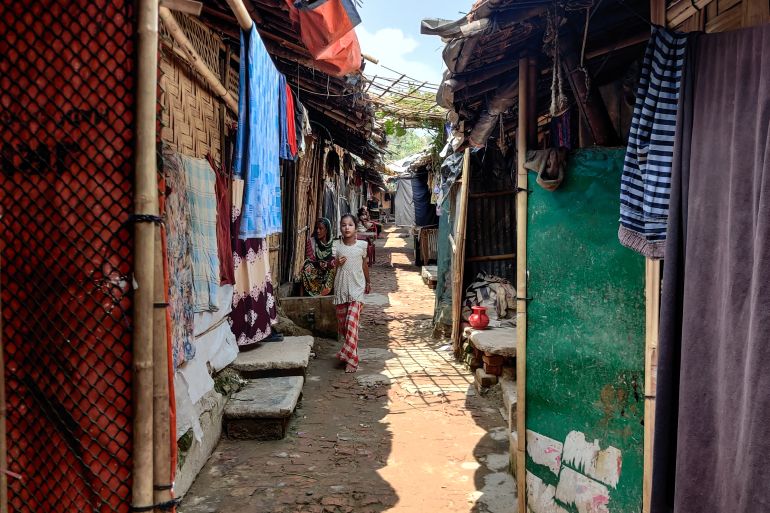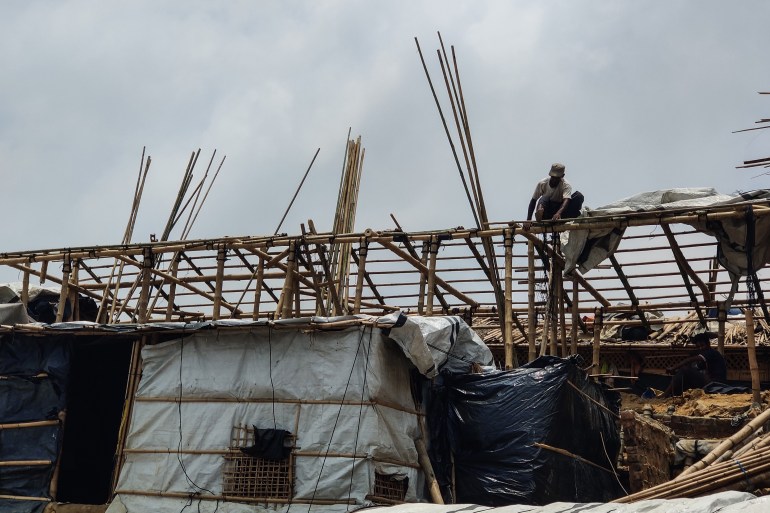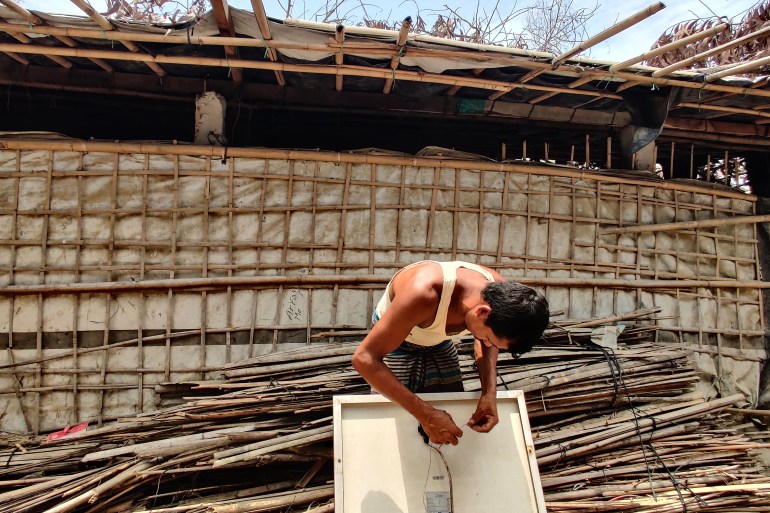Rohingya refugees in Bangladesh’s ‘hot zone for climate threats’
Bangladesh’s southeastern coastal population and the estimated one million Rohingya it accommodates face dire consequences from extreme weather.

Cox’s Bazar, Bangladesh – Climate experts in Bangladesh have expressed concern about massive refugee camps here – some of the largest in the world – being located in an extreme-weather hot zone.
Cox’s Bazar, a coastal region in southeastern Bangladesh, is prone to cyclones, wildfires, and landslides. Without prompt climate mitigation action and investment, Bangladesh’s coastal population and the estimated one million Rohingya refugees it accommodates are under severe threat, analysts say.
Keep reading
list of 4 itemsWhat does the future hold for Rohingya refugees?
Fire at Rohingya camps ‘planned sabotage’, Bangladesh panel says
Myanmar team visits Cox’s Bazar for Rohingya repatriation project
Although it narrowly escaped Cyclone Mocha’s worst impacts, the area remains at great risk, scientists warn.
Saleemul Huq, a climate scientist and director of the International Centre for Climate Change and Development, said landslides pose the biggest problem in the Rohingya camps. Predicting heavy rainfall patterns and cyclones is a challenging task, and this was evident during the recent encounter with Cyclone Mocha.
“While Bangladesh as a whole may be well-prepared, Cox’s Bazar remains a hot zone for climate threats,” Huq told Al Jazeera.
“The timing of cyclones is unpredictable as we saw with the recent threat towards Cox’s Bazar. Although the camps are aware of the problems, the lack of cyclone shelters poses a major issue. Unlike other coastal areas in Bangladesh, the camps lack proper shelters.”
If a cyclone were to directly hit Cox’s Bazar, the situation would be devastating, he said.
“Bangladesh has been making progress in addressing climate change, but we must acknowledge the lack of cyclone centres in the camps, putting Rohingyas in great danger.”
The climate scientist said action must be taken to ready the camps for the weather-related disasters to come.
“As the impacts of human-induced climate change become more and more apparent and visible and lead to significant losses and damages, it is necessary for all actors, including governments as well as others, to work together in a whole-of-society approach going forward,” Huq said.
Bangladesh is one of the most climate-vulnerable nations in the world and tens of millions of people may be forced to flee the low-lying coastline as sea levels rise in the coming years.

‘Could have been killed’
In the aftermath of Cyclone Mocha, which hit neighbouring Myanmar’s western state of Rakhine the hardest, Cox’s Bazaar district was impacted with more than 450,000 people affected, including more than 21,000 Rohingya refugees.
Nur Ayesha, a 25-year-old Rohingya, shared her harrowing experience and the challenges her family faces after the storm.
“On the day of the cyclone, my children went to school while I stayed at home with my youngest daughter,” Nur Ayesha recalled.
“Suddenly, a tree fell inside the house on me while I was cutting fish to prepare our meal. It was fortunate the tree wasn’t too big, as both my daughter and I could have been killed. Trees fell from all sides of my house, leaving my house broken, and the solar panel was blown away. My husband is repairing the solar panel now.”
Nur Ayesha expressed disappointment at the lack of support received from aid organisations for the clean-up. “Nobody provided me with bamboo or any materials to fix my house. In the area where I used to do farming, I managed to gather some bamboo on my own. I want to strengthen my household, but it’s difficult to obtain the necessary materials.”

‘Burn in the flames’
Laila Begum, a 50-year-old woman from the camps, pressed for better preparation from the fallout of extreme weather, describing her experience with Cyclone Mocha.
“The wind blew off the thatch, ruining our clothes and belongings inside. With no men in the household, only me and my daughters, we were terrified and drenched by the heavy rain. The downpour caused water to seep into the house. We need a stronger foundation to prevent such incidents in the future,” Begum told Al Jazeera.
The camps are extremely vulnerable to the effects of climate change. The materials used for constructing shelters are highly prone to fires, a reality that contributes to a pervasive sense of uncertainty and helplessness among the residents.
Mohammad Hasan, 60, a Rohingya refugee, expressed concern about the close proximity of homes in the camps and the risks from scorching temperatures.
“Each house is close to another and if a fire were to break out, we would have no choice but to burn in the flames,” he said.
Nur Islam, a 42-year-old refugee shopkeeper in the camps, rushed home as Cyclone Mocha’s winds picked up. “My nephew and I secured the thatch on our house and shop, anchoring the solar panels with ropes to protect them from the cyclone.
“The government and NGOs provided assistance to those with total losses, but families with less damage didn’t receive any help. I had some materials that I used to reinforce my house, but I need stronger materials.”
Hope for tomorrow?
Sanjeev Kafley, from the International Federation of Red Cross and Red Crescent Societies (IFRC), highlighted the profound climate threats faced by the Rohingya refugees, as well as their hosts along Bangladesh’s coast.
“It is essential to acknowledge that these challenges extend beyond the confines of the camps, affecting the broader local community. Cyclones do not discriminate; they impact both the camps and the host community,” said Kafley.
“This crisis remains unpredictable with an uncertain duration and an unknown future. The need for ongoing humanitarian assistance is undeniable, making it crucial for us to explore strategies to ensure our actions are both sustainable and climate conscious.”
Kafley linked the challenges of climate threats in the refugee camps with the state of despair among the Rohingya population.
“When you don’t have hope it is painful, we are all actually surviving with hope. These risk factors around climate change in the camps persist because of the absence of a durable solution. The hope isn’t there,” he said.
“We must examine how the global community perceives this agenda and join forces to support climate-friendly humanitarian actions in Cox’s Bazar.”